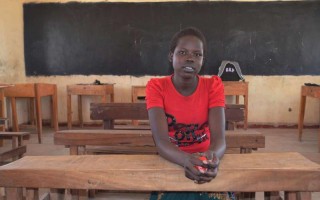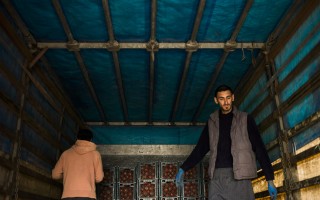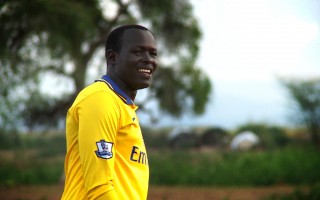
Raouf Mazou, third from left, interacts with refugees in Kakuma refugee camp, Kenya, January 2019. © UNHCR
UNHCR’s new Director of the Africa Bureau, Raouf Mazou, says the socioeconomic inclusion of refugees is vital to the agency’s efforts to protect and assist them.
By Ariane Rummery in Geneva
The lightbulb moment for Raouf Mazou, who recently wound up a five-year stint as representative in Kenya for UNHCR, the UN Refugee Agency, came on a visit to Kakuma refugee camp with colleagues from the World Bank who helped him see a familiar site with fresh eyes.
“We were walking around the camp and as usual I was focusing on vulnerability,” Mazou recalls. “But at one point, my colleague just stopped in front of a mobile phone shop and said: ‘This is interesting. Does this mean people are buying mobile phones here? And what about that person selling the phones? What is his capital, and how can he be helped?’”
The joint visit, which also ‘revealed’ entrepreneurs selling internet access, electricity and motorcycle taxi rides, prompted a sea change in how Mazou thought about his job, from focusing mainly on helping the vulnerable to how to invest in refugees’ capacity too.
“Other people were seeing the potential in a refugee camp that we were not necessarily seeing with our purely humanitarian lens,” he said.
“We tend to go to a place and look at those who suffer the most, who are in need of our intervention. But we don’t look at those who are talented, those who have potential and those who are already doing things.”
While Mazou was Representative in Kenya, UNHCR worked with the World Bank Group on two groundbeaking reports which are shifting the narrative on refugees in Kenya and beyond. Yes, in my backyard (2016) found that the presence of refugees in the Turkana region had led to economic growth there, while Kakuma as a market place (2018) found that the 180,000 refugees in and around the camp were contributing to an economy worth US$56 million a year, sparking a programme to encourage more private-sector investment.
As UNHCR pursues greater self-reliance of refugees globally, alongside other key objectives of the global compact on refugees, the Director of the Regional Bureau for Africa talks to Senior Communications Officer Ariane Rummery about his recent experience applying the compact’s comprehensive approach in Kenya.
Tell me about a refugee you met recently who could really flourish with the kind of support envisaged in this new ‘comprehensive approach’?
I was in Kakuma recently and met a lady who was a seamstress with a tailoring shop. She is doing fairly well, with six or seven employees. When I asked, “What more would you need?”, she said the type of material available to her was limited. “I know that in Côte d’Ivoire they sell very good material, but I need a document to travel there,” she said. She actually needs a Convention travel document.
This kind of small business person might also need training to improve bookkeeping skills, a small loan or an insurance product to insure herself against illness, in case she is not working for two, three or five days.
The nature of situations we are dealing with means people can live in a refugee camp for 20 years. So our response cannot just be food distribution every month; our response must be also to address people’s hopes, their expectations and their willingness to be included in the society where they are.
And our work with the World Bank has helped us discuss these things with the government, which now agrees that an approach that includes refugees in the socio-economic life of the country is better. Better for refugees, better for the country and the population that has welcomed them.
Where does the private sector fit in?
We’re talking about the local private sector here, like the seamstress I just spoke about. It’s the people who have always been there but whom we’ve never seen. These are the people who create jobs, and who provide the services that refugees require.
This crucial private sector has to be formalized and grown. Formalized in the sense that the government has to recognize their presence; they have to pay taxes, they have to register, and perform all the requirements to have a business. And they need to be provided with some support, like small loans, which in turn will help strengthen the economy of the place where they live.
It’s through supporting these private-sector initiatives and the ability of refugees to fend for themselves, to create value and wealth, that we will help them be economically included.
Refugees who have been able to grow small businesses are really the gateway, the key to inclusion of the entire refugee population. Once you have individuals who are already part of the economy, then talking to a government about economic inclusion is much easier. At least that was the strategy and the approach that we had in Kenya.
The Governor of Turkana County (in north-west Kenya and one of the poorest regions) is one of the biggest champions of this new approach. Why is the buy-in of local authorities so crucial?
It is important because at the end of the day it is about them. It is about them receiving a significant foreign population – in this case 180,000 refugees out of a county which has 1.2 million inhabitants. So it’s about them welcoming refugees, including them and thereby protecting them.
We are talking about protection of refugees through their inclusion and the willingness of the population to receive them in the social-economic fabric of their community.
In what ways has UNHCR changed its own programmes to help foster the local inclusion of refugees?
There are many ways but a key one involves cash-based interventions for housing. In many situations we build housing for refugees through partners and then give the houses to refugees. In Turkana and Kalobeyei, we give cash to the refugees via a debit card and they engage contractors directly to build the houses. The refugees have full involvement. I saw an example of a refugee sending back a truck full of sand saying it was not good quality and therefore we don’t want it. The result has been better quality and faster construction.
And most of the money is injected into the local economy – to pay for sand, stones and labour and whatever else is required to build a house. Very little of it comes from outside the community and you can see the difference it makes transformed into consumption – people are dressing in a better way and have more resources in their pockets.
The cost of a house is US$1,300 and last year we injected about US$1.5 million into the programme. This year it will be about US$2.5 million.
What do you say to the critics who may be concerned this new approach will lead to the vulnerable being ignored?
I think it is very important to be very attentive to the critics. We’ve had a system in UNHCR which focuses on the most vulnerable. What we’re saying now is that we will continue to focus on the vulnerable, and in addition to that we will also provide support to those people who are not necessarily vulnerable but who could do even better if we help them.
At the end of the day, I think we should all try and move towards refugees leading normal lives. Even some of those who are critical of the new approaches are also anxious to make sure refugees have all their rights and live normal lives.
From your new position as bureau chief for the whole of Africa, how will refugee situations look different in five to 10 years’ time due to this new approach?
I hope that refugees will have been able to contribute to the economic development of the places which have welcomed them. And I hope that regions which receive refugees will be able to find extra resources for economic and infrastructure development, such as the new finance (concessional loans or grants) the World Bank is making available to countries receiving refugees (like IDA-18) or through private-sector investment.
And I hope we will have a larger percentage of refugees who will be fending for themselves, and a smaller percentage who require humanitarian assistance and we’ll be able to use that limited aid better.
We can support the hopes, aspirations and dreams of people who can continue to grow while they are in exile, and then also be in a better position to go back to their country of origin when they are able to, and be part of the reconstruction.
What is the big anniversary for Africa in 2019 and why does it matter?
It’s the 50th anniversary of the OAU Convention on Refugees – a very progressive, very positive piece of international law – and an occasion to reflect and discuss how it has been implemented, and what we can do better.
It was developed at a time in the late 1960s when refugee contexts were very different from what we have today. I think the expectation at the time was that conflicts would not last and refugees would go home fast. Now, unfortunately that has not been the case. Once you are in a country for five, 10 or 20 years you need to look at things differently. So we have to look more at economic development more than we did in the past, and socio-economic inclusion.
Africa remains a very welcoming continent. It has the largest population of refugees, so it’s a place where we can and must have this reflection on how we can do better. And we have to look at the root causes, not just the consequences.
And for those who have concerns – about high levels of local unemployment or security for example – we need to show that there are contexts whereby refugees can actually create jobs and that technologies today can ensure proper registration in a way that protects refugees and the local population which welcomes them.
Originally published by UNHCR on 04 April 2019





